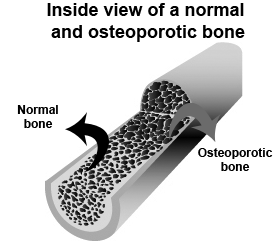Osteoporosis
Osteoporosis is a disease that causes the bones to deteriorate. As bones lose mass, they become more porous. This makes them more fragile, which increases the risk of fractures.

There are usually no symptoms or warning signs of osteoporosis until you fracture a bone. Fractures most commonly occur in the hips, spine, wrists, and shoulders.
Fractures can result from a very weak blow or a minor fall. They can even occur with no apparent cause. Fractures are often painful. However, some can be painless, such as spinal fractures.
Because osteoporosis has no symptoms other than broken bones, it is recommended that people at risk for osteoporosis take a bone mineral density (BMD) test to see if they have the disease.
Causes and triggers
Osteoporosis is caused by a significant loss of bone mass.
The disease can affect people of all ages. Some people are more likely to develop it. Below are the most common risk factors:
- Aging
- Being a woman
- Family history of osteoporosis
- Certain diseases (e.g., rheumatoid arthritis, celiac disease)
- Malnutrition
- Low levels of calcium and vitamin D
- High alcohol consumption
- Smoking
- Lack of physical activity
- Certain medications
Treatment
There are various treatments available for osteoporosis. Some of them slow bone loss, while others stimulate the formation of bone tissue. Some medications are taken orally (e.g., alendronate and risedronate), while others are injectable (e.g., denosumab and zoledronic acid).
To reduce your risk of fracture, whether you have osteoporosis or not, it's essential to adopt healthy lifestyle habits. These should be maintained even if you've started treatment with medication. Here are a few examples:
- Exercise:
- Weight-bearing aerobic activity (e.g., walking, jumping rope, jogging)
- Strength training or weight training (e.g., lifting weights)
- Activities that require balance (e.g., tai chi or yoga)
- Eat plenty of calcium-rich foods (e.g., milk, cheese, salmon, legumes, dietary supplements)
- Eat a diet rich in vitamin D (e.g., eggs, fortified milk and soy products)
- Taking supplemental vitamin D is often recommended for people over the age of 50
- Drink alcohol in moderation
- Quit smoking
When should I see a health care professional?
Speak with your health care provider in the following situations:
- You have several risk factors for osteoporosis
- You're experiencing pain after a fall
For more information:
© Copyright Vigilance Santé
The patient information leaflets are provided by Vigilance Santé Inc. This content is for information purposes only and does not in any manner whatsoever replace the opinion or advice of your health care professional. Always consult a health care professional before making a decision about your medication or treatment.
